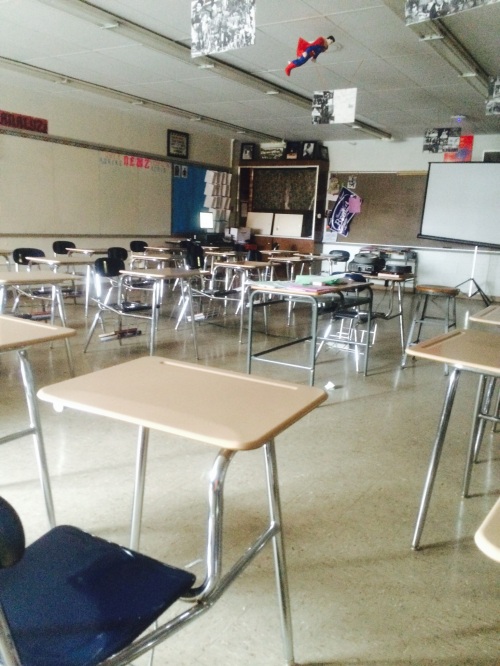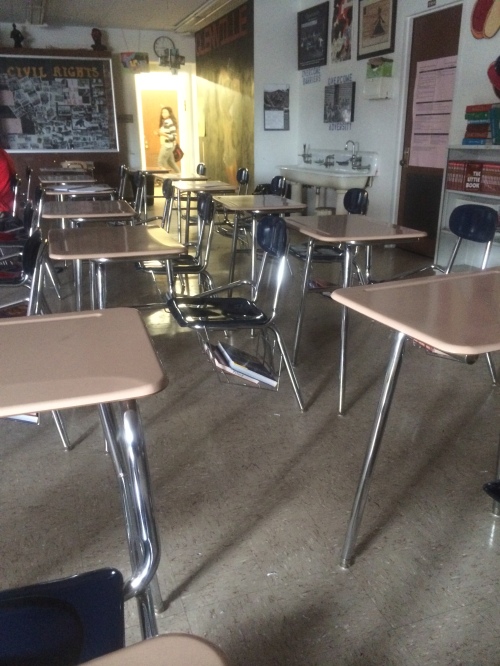Larry Cuban on School Reform and Classroom Practice: Teaching U.S. History in a Failing School (Part 1)
I observed this teacher teaching three history classes a few months ago in a persistently low-performing high school on the cusp of being “restructured.” All names are fictitious.
Standing in the hallway outside of his classroom—a school policy as students move from one class to another–Mark Allison sports a gray-flecked goatee, mustache, and a ponytail of braided dreadlocks. He is wearing a lavender tie on a light, patterned purple shirt with dark-gray cargo pants. A man in his mid-50s he is friendly with students as they pass by calling many by name or “sister” and “brother.” Most of the students say “hi” back, wave, bump fists or shake hands.
Allison teaches African American history and U.S. government. A veteran teacher, he has taught in the District 36 years of which 28 have been at Greenwich High School.
As the tardy chimes sound for the 40 minute period to begin, Allison closes the door and enters a bright, large classroom. On the wall behind the teacher’s desk in one corner of the room (a laptop, the only computer device in the room, sits on Allison’s desk) is a large bulletin board filled with photos of students in his classes. On the opposite wall is a glass-enclosed case displaying famous photos of individuals and events of the Civil Rights movement in the 1960s. Student desks are arranged in a horseshoe with Allison sitting at a student desk in the center of the horseshoe with a slide carousel projector ready for the day’s lesson.
There are three students in the class. Within 10 minutes there are four more. Five minutes before the end of the period, another student enters.
The lesson I observed was part of the unit he teaches on the Civil Rights movement. He begins with the three students by passing out four cards to each one with questions and answers on events during the 1950s and 1960s.
In a game he invented, one student asks a question and another student has to figure out which of the answers he or she has on the four cards is the correct one. As a tardy student entered, Allison paused and said: “are you ready to learn, brother?” He then gave the latecomer the four cards and explained the game quickly. The students were immediately involved and the group expanded to six as latecomers arrived. All six used the Q & A on the cards in their hands as they traded questions and answers (according to Allison’s records, 20 students are enrolled in the course).
Allison sits close to the students listening and, from time to time, coaching those who were having difficulty in either providing an answer or matching the right one to the question asked. For example, one of the questions on the card asks about affirmative action and students were stumped. Allison then gives an example of one of his students who applied to Clark University in Atlanta (GA), a historically black institution, and Akron University. A largely white institution, Akron had encouraged blacks to apply and, in the past decade, had selected more and more black applicants. One student grasps the example and answers “affirmative action” on one of his four cards. In the midst of the game, a PA announcement interrupted the lesson telling teachers that they must turn in a letter of commitment that day if they want to re-apply for their position next year. After the interruption, the game continues.
With the six students—the seventh arrived just before the bell rang—Allison turns to the slide carousel. The first slide he projects on a pull-down screen in the front of the room was labeled: “You Can’t Kill an Idea.” In rapid-fire questions, Allison asked: “What does that mean?” Few scattered responses and Allison tries another question: “What one word captures the Civil rights movement?” Students yell out answers such as: “Marches.” “Protests.” “Freedom.” “Riots.” “Equality.” “Rights.” “Prejudice.” Allison picks “freedom” and “equality” and says that is what the movement was about.
He then pushes the carousel button and a photo of a bus with mostly empty seats comes on the screen with one black woman sitting on the bus. The teacher asks: “What is this picture about?” Students offer different details of the black woman (age, color, tired look on her face, etc.), and a white bus driver (age, color, facial features, etc.) and the fact that no one else was on bus. Allison then asks one student: “Sister, what is this picture depicting?” Before she could answer, he admonished the others: “No one else help her.” She mentions the phrase “bus boycott” and teacher smiles.
He then goes to next slide which shows a photo of angry white women, men, and students yelling at and spitting upon 15 year-old Elizabeth Eckford, one of the “Little Rock Nine” who was trying to enter Little Rock High School (ARK) in 1957. Allison asks the seven students what the photo depicts. Students call out: “She looks calm,” “white people are sure angry at her,” “except for her, there are no other black people around.” Allison points out that Eckford was their age. He keeps students’ attention focused on photo as they supply additional details. He then asks class: “What would you do if there were hundreds of people screaming and spitting at you?” Students’ choral responses range from running away from crowd to fighting back to crying to doing what Eckford did.
The teacher runs through a series of slides—one of which shows James Meredith entering the University of Mississippi (none of the students recognized Meredith) another shows a white child in a small crowd holding a sign that says: “Who Needs Niggers?” The same sign had a painted swastika and Confederate flag. One of the students asks Allison about the swastika. He explains the symbol. Then he asks about the flag. No one in the room could identify the flag.
One slide shows a black woman being arrested for entering a “whites only” library. Teacher says to class: “Listen, I can’t get you to go to the city library which is free and open to everybody.” Another slide features two black athletes at the 1968 Olympics in Mexico City with raised fists in a black power salute. Most of the students recognize the photo. A photo of Rosa Parks, all students identify. Ditto for the mug shot of Malcolm X. When the photo of the 1963 event appears on the screen, students yell out in chorus “the March on Washington”. As a follow-up on that photo, Allison asks the seven students what the obelisk was behind the marchers. Some students shrug; others said, “I don’t know.” No one identifies the Washington Monument.
For each slide, Allison poked, prodded, and pushed students to offer details in the photo and then segued to questions that sought the meaning of these different events during the Civil Rights movement. Effortlessly, he gave present-day examples that could tie his students’ experiences and knowledge to events a half-century ago.
Just before the period ended, a PA announcement interrupted the lesson. The principal reminded teachers to turn in their applications should they want to teach at Greenwich in the Fall. Here was the newest reform in the district: low-performing schools will be restructured into better schools. For this to occur there will be a new principal and current Greenwich teachers will have to reapply for their positions. The lesson resumed.
By the end of the 40-minute period, all of the students including latecomers were thoroughly engaged with the Q &A over the slides. After the chimes rang two students went over to see the photos in Allison’s glass case.
In the two other classes I observed Allison teach, there were 12 and 22 students. He basically used the same techniques of cards with questions and answers at the beginning of the class and the photos in the slide carousel. The level of student engagement, the repartee and rapport with students, and prodding them to think about what they said were just as evident in these lessons as the period that I observed with seven students.
How can I and readers make sense of Mark Allison’s three lessons that I observed? Part 2 answers that question.
This blog post has been shared by permission from the author.
Readers wishing to comment on the content are encouraged to do so via the link to the original post.
Find the original post here:
The views expressed by the blogger are not necessarily those of NEPC.


